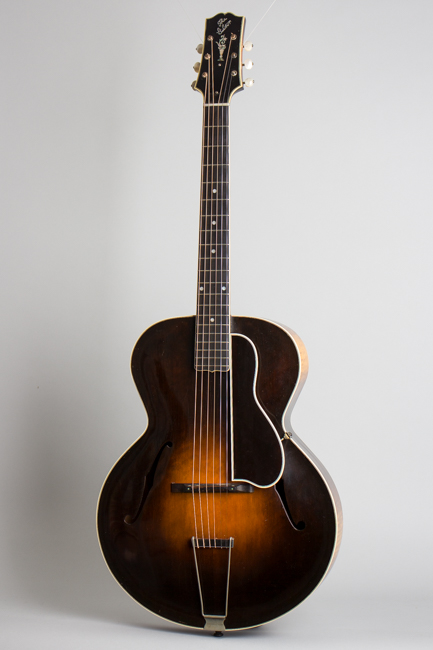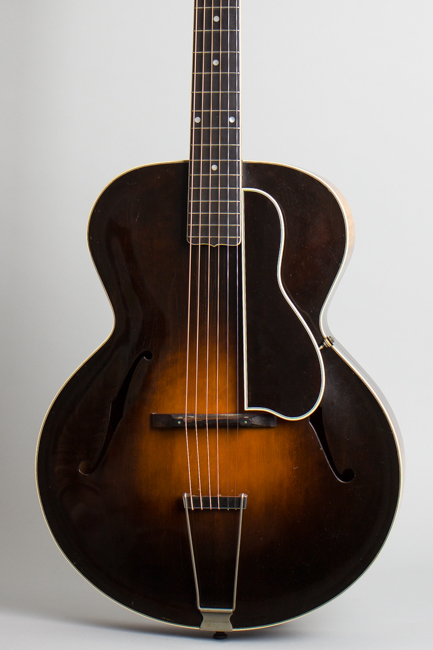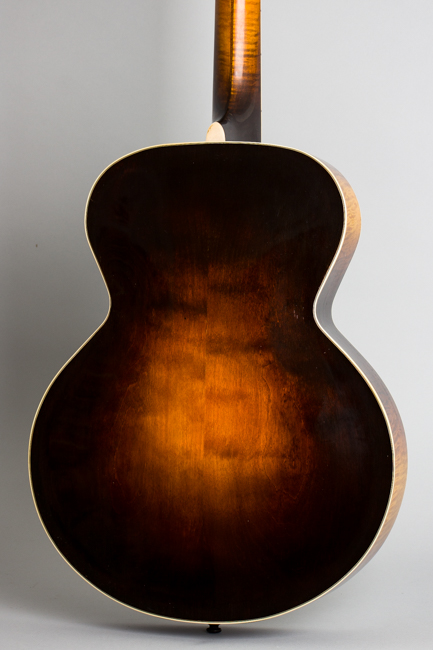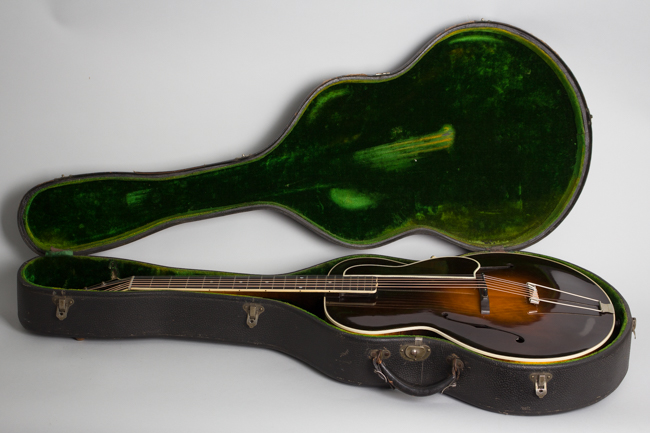Gibson L-5 Master Model Arch Top Acoustic Guitar (1924)
Gibson L-5 Master Model Model Arch Top Acoustic Guitar (1924), made in Kalamazoo, Michigan, serial # 77391, Cremona Brown Sunburst finish, curly maple sides, birch back, spruce top; laminated maple neck with ebony fingerboard, original black hard shell case.
This beautiful, iconic early Gibson represents one of the most historically important guitars of the 20th century, and a considerable rarity. It is a 1924 Master Model L-5, the label signed by "Master" Lloyd Loar on November 17th of that year. It was not only the pre-eminent professional guitar of its era, but THE original f-hole archtop guitar, the progenitor of a century of similar guitars to come. Beyond this it remains an extremely fine-sounding instruments by any standard.
Debuting in 1923-4, the L-5 was the first modern archtop combing violin style f-holes, a 14 fret neck joint and an elevated fingerboard. At the time this one in was built in mid/late 1924 the design was little more than a year old, the new top of Gibson's line. By the end of the 1920s other makers would adopt the concept, with the L-5 as inspiration for all and a template for legions of f-hole guitars that followed.
This L-5 was incomparable when new, the only instrument of its type extant. Designed originally to supplement mandolin orchestras, the L-5 became the first "jazz" guitar and the driving force behind the guitar's replacement of the banjo in the orchestra rhythm sections. It is safe to say that modern guitar playing would not have evolved as it did without the invention of this instrument, the first guitar to be able to hold its own among horns and drums. In 1924 the L-5 had no competition; the context of an orchestra guitar was not yet extant.
The Loar-signed "Master Model" L-5 is very rare today. About 33 are documented to exist, many of which are altered from original in various ways. It was extremely expensive when new retailing at $275.00 (plus case!); a top-of-the-line pearl-trimmed Martin Style 000-45 was $105.00 less. There was hardly any market for them; in 1924 there were few professional guitarists who could afford or even need such an instrument. Eddie Lang changed all that later in the 1920s switching from banjo to a Gibson L-4 then an L-5, setting the trend for all to follow.
This guitar carries a "Master Model" label under the bass side F-hole used only on Style 5 instruments and Lloyd Loar's signature dated November 17, 1924, on a second label under the treble F-hole. Oddly enough, this is the ONLY known label signed this date; nearly all the others run in larger batches. The serial number hand-written on the upper label suggests shipment in early 1925, right after Loar left the building. Any Factory Order Number on the back is covered by the Loar-signed label.
This instrument has a third label spotlighting the addition of one of Loar's obsessions, the "Virzi Tone Producer", mounted under the top. This device was marketed by Virzi Bros. violin company in New York. It is flat thin spruce disc suspended beneath the top beneath the bridge, claimed to enhance soundwave vibrations in the tone chamber supposedly enhancing harmonic partials. Championed by Loar, it was offered by Gibson as an optional feature at the time. The Virzi is found in many Gibson Master Model mandolins and most L-5's from 1924-5.
This guitar shows other typical features for a 1924 "Master Model" L-5. The pearl dot inlayed, 20 fret ebony fingerboard is single bound ending in a curled point. The 3-piece curly maple neck has a medium "V" profile, which gets sharper near the nut. The frets are the thin wire of the era; the nut is genuine pearl. The pearl inlaid flowerpot in the triple-bound "snakehead" headstock and sharply angled "The Gibson" logo are the hallmarks of the original L-5. The elegant engraved, silver plated, mother-of-pearl buttoned tuners are unique to this model.
The body on this guitar is, like many early L-5s, just a hair over 16 inches wide, triple-bound back and front. The carved spruce top sits over flamed maple sides and a birch back; soon after it was made Gibson switched to a maple back. The top has solid hand-carved parallel braces. The body carries a beautifully blended dark Cremona Brown sunburst finish. The triple bound celluloid pickguard and mounting hardware are original. The tailpiece with a "string over" cross bar and ebony bridge (stamped "PAT'D JAN 18-21.") are original.
Most early 16" L-5s were used extensively for many years, some owners continuing to prefer them to any later guitars. They are still often seen in the hands of recording studio players well into the 1960s. As working guitars, these instruments have often been heavily modified, refitted, or refinished. This one is far better preserved and more original than most, retaining all of its original character. This guitar has a powerful and very versatile sound, simultaneously warm and incisive with plenty of depth. It plays extremely well and is exceptionally responsive for an archtop guitar...it even sounds lovely fingerstyle! Eddie Lang, MayBelle Carter, Snoozer Quinn, Nick Lucas and many more would approve! This is a wonderful example of one of our all-time favorite instruments, both historically important and a true delight to play.
Overall length is 40 1/2 in. (102.9 cm.), 16 1/16 in. (40.8 cm.) wide at lower bout, and 3 3/8 in. (8.6 cm.) in depth, measured at side of rim. Scale length is 24 3/4 in. (629 mm.). Width of nut is 1 3/4 in. (44 mm.).
This guitar is exceptionally well preserved, about as nice as it would be possible to find for an instrument rapidly approaching its 99th birthday! The finish overall shows only very minor wear marks and light checking in spots. The top and back look to have possibly been polished lightly over the years, but there is no evidence of any additional finish or overspray. There are small dings, dents and chips here and there but no serious finish loss.
All the hardware is original and complete including the silver plated, pearl button tuners, string-over tailpiece and bound pickguard with its fragile celluloid mounting bracket. The thin-wire original frets remain in excellent shape and really this guitar looks to have simply not been played much over nearly a century. This is simply a stunning example of this extremely rare and historic guitar, as fine playing and sounding an instrument today as when Master Loar's label was signed in November 1924. It resides in its original black case, a timelessly elegant and beautiful instrument both visually and sonically; an inscrutable visitor from a seemingly distant age. Excellent Condition.
This beautiful, iconic early Gibson represents one of the most historically important guitars of the 20th century, and a considerable rarity. It is a 1924 Master Model L-5, the label signed by "Master" Lloyd Loar on November 17th of that year. It was not only the pre-eminent professional guitar of its era, but THE original f-hole archtop guitar, the progenitor of a century of similar guitars to come. Beyond this it remains an extremely fine-sounding instruments by any standard.
Debuting in 1923-4, the L-5 was the first modern archtop combing violin style f-holes, a 14 fret neck joint and an elevated fingerboard. At the time this one in was built in mid/late 1924 the design was little more than a year old, the new top of Gibson's line. By the end of the 1920s other makers would adopt the concept, with the L-5 as inspiration for all and a template for legions of f-hole guitars that followed.
This L-5 was incomparable when new, the only instrument of its type extant. Designed originally to supplement mandolin orchestras, the L-5 became the first "jazz" guitar and the driving force behind the guitar's replacement of the banjo in the orchestra rhythm sections. It is safe to say that modern guitar playing would not have evolved as it did without the invention of this instrument, the first guitar to be able to hold its own among horns and drums. In 1924 the L-5 had no competition; the context of an orchestra guitar was not yet extant.
The Loar-signed "Master Model" L-5 is very rare today. About 33 are documented to exist, many of which are altered from original in various ways. It was extremely expensive when new retailing at $275.00 (plus case!); a top-of-the-line pearl-trimmed Martin Style 000-45 was $105.00 less. There was hardly any market for them; in 1924 there were few professional guitarists who could afford or even need such an instrument. Eddie Lang changed all that later in the 1920s switching from banjo to a Gibson L-4 then an L-5, setting the trend for all to follow.
This guitar carries a "Master Model" label under the bass side F-hole used only on Style 5 instruments and Lloyd Loar's signature dated November 17, 1924, on a second label under the treble F-hole. Oddly enough, this is the ONLY known label signed this date; nearly all the others run in larger batches. The serial number hand-written on the upper label suggests shipment in early 1925, right after Loar left the building. Any Factory Order Number on the back is covered by the Loar-signed label.
This instrument has a third label spotlighting the addition of one of Loar's obsessions, the "Virzi Tone Producer", mounted under the top. This device was marketed by Virzi Bros. violin company in New York. It is flat thin spruce disc suspended beneath the top beneath the bridge, claimed to enhance soundwave vibrations in the tone chamber supposedly enhancing harmonic partials. Championed by Loar, it was offered by Gibson as an optional feature at the time. The Virzi is found in many Gibson Master Model mandolins and most L-5's from 1924-5.
This guitar shows other typical features for a 1924 "Master Model" L-5. The pearl dot inlayed, 20 fret ebony fingerboard is single bound ending in a curled point. The 3-piece curly maple neck has a medium "V" profile, which gets sharper near the nut. The frets are the thin wire of the era; the nut is genuine pearl. The pearl inlaid flowerpot in the triple-bound "snakehead" headstock and sharply angled "The Gibson" logo are the hallmarks of the original L-5. The elegant engraved, silver plated, mother-of-pearl buttoned tuners are unique to this model.
The body on this guitar is, like many early L-5s, just a hair over 16 inches wide, triple-bound back and front. The carved spruce top sits over flamed maple sides and a birch back; soon after it was made Gibson switched to a maple back. The top has solid hand-carved parallel braces. The body carries a beautifully blended dark Cremona Brown sunburst finish. The triple bound celluloid pickguard and mounting hardware are original. The tailpiece with a "string over" cross bar and ebony bridge (stamped "PAT'D JAN 18-21.") are original.
Most early 16" L-5s were used extensively for many years, some owners continuing to prefer them to any later guitars. They are still often seen in the hands of recording studio players well into the 1960s. As working guitars, these instruments have often been heavily modified, refitted, or refinished. This one is far better preserved and more original than most, retaining all of its original character. This guitar has a powerful and very versatile sound, simultaneously warm and incisive with plenty of depth. It plays extremely well and is exceptionally responsive for an archtop guitar...it even sounds lovely fingerstyle! Eddie Lang, MayBelle Carter, Snoozer Quinn, Nick Lucas and many more would approve! This is a wonderful example of one of our all-time favorite instruments, both historically important and a true delight to play.
Overall length is 40 1/2 in. (102.9 cm.), 16 1/16 in. (40.8 cm.) wide at lower bout, and 3 3/8 in. (8.6 cm.) in depth, measured at side of rim. Scale length is 24 3/4 in. (629 mm.). Width of nut is 1 3/4 in. (44 mm.).
This guitar is exceptionally well preserved, about as nice as it would be possible to find for an instrument rapidly approaching its 99th birthday! The finish overall shows only very minor wear marks and light checking in spots. The top and back look to have possibly been polished lightly over the years, but there is no evidence of any additional finish or overspray. There are small dings, dents and chips here and there but no serious finish loss.
All the hardware is original and complete including the silver plated, pearl button tuners, string-over tailpiece and bound pickguard with its fragile celluloid mounting bracket. The thin-wire original frets remain in excellent shape and really this guitar looks to have simply not been played much over nearly a century. This is simply a stunning example of this extremely rare and historic guitar, as fine playing and sounding an instrument today as when Master Loar's label was signed in November 1924. It resides in its original black case, a timelessly elegant and beautiful instrument both visually and sonically; an inscrutable visitor from a seemingly distant age. Excellent Condition.












